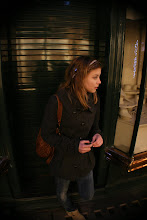Cinematography Lighting
The cinematographers in this video had a very creative way of talking about the way lighting affects a film. They described the technical aspects of lighting and the way that reflects directly onto the mood that the film has. A great quote that really stuck out to me was when one of the cinematographers said that you must know your story inside out before you can begin to imagine the lighting of the set. I believe this is a very important point because if you have no direction, anything you try to do will have no purpose and will be there just to be there. The way most of them begin to light scenes is by going onto the set, and then beginning to light it with just one light, and just like that they add one by one until the finished product looks like what they've imagined. It is pretty much just like a painting, you start with a blank canvas and work your way with different colors and layers.
Chris Doyle's Master Class
Christopher Doyle describes a cinematographer as the one who decides exactly what goes onto the screen. He is in charge of mise-en-scene. He mentions using light as a way to create space. By using different lighting from a series of angles, it can change the mood and feel of the film/scene. He gave great advice on the way he creates his scenes. He says that it is not just thought up, but you have to go to a location, and by that you can build on top of what you have with what is available.-Different walls/windows/lights/shadows, etc. Christopher Doyle also compares the difference between the cinematogrophy in western films, as compared to eastern films. He states how western films tend to make the mise-en-scene very obvious, while easterners consider everything in the mise-en-scene and expect the audience to find what it is that is the most important.
Children of Men Emmanuel Lubezki
In this video the cinematographer and the director talk about filming the very important scene of the uprising when Theo rescuing the girl. This scene was very important to the film as it is where the climax and the main action happened. Everything comes together at this scene. The cinematographer Emmanuel Lubezki talks of filming this entire scene in one whole shot as to make it seem much more realistic. It was all from the main character Theo's view- to see what are the affect of him being thrown into such a situation are. At this poin there were not many cut away shots and the focus was on Theo. He also speaks of the lighting that he used. He was only using natural lighting as to create a larger sense of realism. Even during night scenes, only fire was used as lighting in the asylum camps.
skip to main |
skip to sidebar


A2 Practical Production

Who?Why?What?Where?
- Klaudija
- This blog is dedicated to have every detail of my A2 Media Coursework on it. To quickly jump to a post, scroll down to the labels and click on a specific category.Enjoy!
Labels
- A2 Short Film Jan 2010 (1)
- Ancillary Text 1 – Film Poster (8)
- Ancillary Text 2 – Film Review (1)
- AS Opening Sequence June 2009 (1)
- Auditions and Rehearsals (3)
- Call Sheet (1)
- Character Profiles (2)
- Costume and Props (1)
- Director's Master Class (1)
- Editing (2)
- Evaluation 2 (1)
- Evaluation 3 (1)
- Evaluation 4 (1)
- Feedback (8)
- Location Recce (1)
- Moodboard (3)
- Research and Planning (9)
- Schooting Schedule (1)
- Script (4)
- Storyboard (3)
- Treatment (3)
- World of Our Film (2)
Looking Back...
-
▼
2009
(47)
-
▼
September
(14)
- More Monsters!
- Monster Script Draft 1
- Collage Feedback & Second Collage
- Monster Research
- World of Our Film Collage
- Cinematography
- Feedback
- Treatment 2-Monster
- Background Research
- Character Profiles for Red Rose Killer
- Feedback Response
- Treatment 1-Red Rose Killer
- Color Red Moodboard
- AS Opening Sequence June 2009
-
▼
September
(14)
0 Thoughts:
Post a Comment